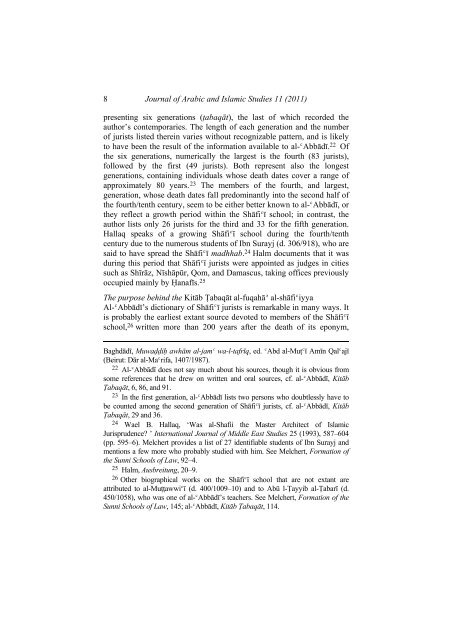JOURNAL OF ARABIC AND ISLAMIC STUDIES
JOURNAL OF ARABIC AND ISLAMIC STUDIES
JOURNAL OF ARABIC AND ISLAMIC STUDIES
Create successful ePaper yourself
Turn your PDF publications into a flip-book with our unique Google optimized e-Paper software.
8<br />
Journal of Arabic and Islamic Studies 11 (2011)<br />
presenting six generations (ṭabaqāt), the last of which recorded the<br />
author’s contemporaries. The length of each generation and the number<br />
of jurists listed therein varies without recognizable pattern, and is likely<br />
to have been the result of the information available to al-ʿAbbādī. 22 Of<br />
the six generations, numerically the largest is the fourth (83 jurists),<br />
followed by the first (49 jurists). Both represent also the longest<br />
generations, containing individuals whose death dates cover a range of<br />
approximately 80 years. 23 The members of the fourth, and largest,<br />
generation, whose death dates fall predominantly into the second half of<br />
the fourth/tenth century, seem to be either better known to al-ʿAbbādī, or<br />
they reflect a growth period within the Shāfiʿī school; in contrast, the<br />
author lists only 26 jurists for the third and 33 for the fifth generation.<br />
Hallaq speaks of a growing Shāfiʿī school during the fourth/tenth<br />
century due to the numerous students of Ibn Surayj (d. 306/918), who are<br />
said to have spread the Shāfiʿī madhhab. 24 Halm documents that it was<br />
during this period that Shāfiʿī jurists were appointed as judges in cities<br />
such as Shīrāz, Nīshāpūr, Qom, and Damascus, taking offices previously<br />
occupied mainly by Ḥanafīs. 25<br />
The purpose behind the Kitāb Ṭabaqāt al-fuqahāʾ al-shāfiʿiyya<br />
Al-ʿAbbādī’s dictionary of Shāfiʿī jurists is remarkable in many ways. It<br />
is probably the earliest extant source devoted to members of the Shāfiʿī<br />
school, 26 written more than 200 years after the death of its eponym,<br />
Baghdādī, Muwaḍḍiḥ awhām al-jamʿ wa-l-tafrīq, ed. ʿAbd al-Muṭʿī Amīn Qalʿajī<br />
(Beirut: Dār al-Maʿrifa, 1407/1987).<br />
22 Al-ʿAbbādī does not say much about his sources, though it is obvious from<br />
some references that he drew on written and oral sources, cf. al-ʿAbbādī, Kitāb<br />
Ṭabaqāt, 6, 86, and 91.<br />
23 In the first generation, al-ʿAbbādī lists two persons who doubtlessly have to<br />
be counted among the second generation of Shāfiʿī jurists, cf. al-ʿAbbādī, Kitāb<br />
Ṭabaqāt, 29 and 36.<br />
24 Wael B. Hallaq, ‘Was al-Shafii the Master Architect of Islamic<br />
Jurisprudence? ’ International Journal of Middle East Studies 25 (1993), 587–604<br />
(pp. 595–6). Melchert provides a list of 27 identifiable students of Ibn Surayj and<br />
mentions a few more who probably studied with him. See Melchert, Formation of<br />
the Sunni Schools of Law, 92–4.<br />
25 Halm, Ausbreitung, 20–9.<br />
26 Other biographical works on the Shāfiʿī school that are not extant are<br />
attributed to al-Muṭṭawwiʿī (d. 400/1009–10) and to Abū l-Ṭayyib al-Ṭabarī (d.<br />
450/1058), who was one of al-ʿAbbādī’s teachers. See Melchert, Formation of the<br />
Sunni Schools of Law, 145; al-ʿAbbādī, Kitāb Ṭabaqāt, 114.

















